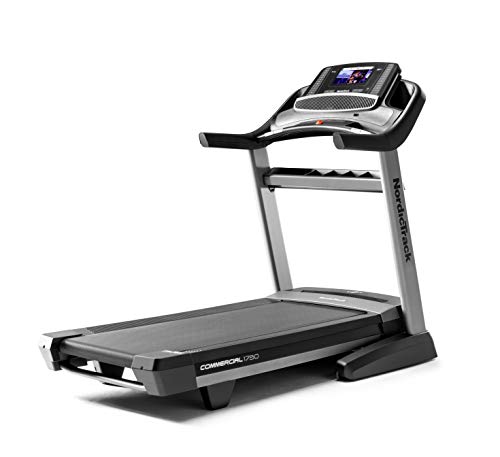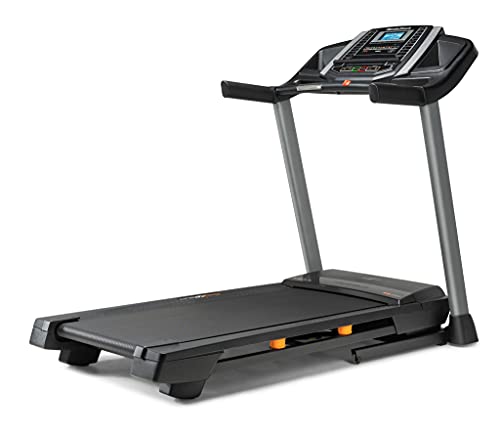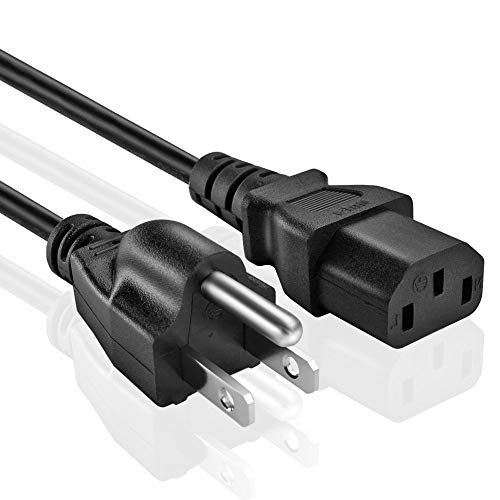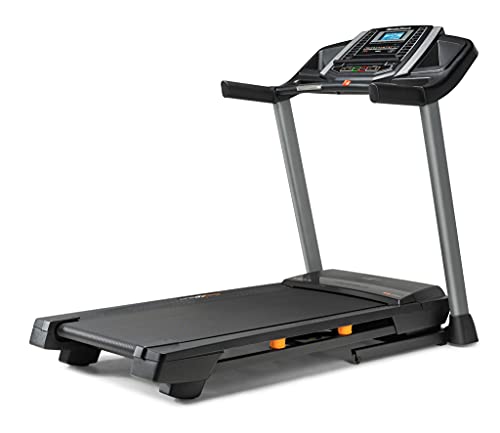Where do you start?
Well, before putting your hand in your pocket to buy a treadmill there are number of factors you need to consider.
Belt size, speed, motor horsepower, displays, deck cushioning, warranty – all of these factors can bias what you buy from the large number of different models currently available.
Horsepower
Unless an exercise treadmill has a strong motor, at least 2.0 CHP, you’ll easily wear it out, even if you only walk moderately. Check for the continuous-duty rating for the motor’s true horsepower and watch out for misleading terms such as “treadmill duty” and “peak horsepower” which are usually gimmicks to unrealistically raise the horsepower.
We recommend a continuous-duty horsepower rating of at least 2.0 CHP, not only because walkers over 200 lbs. create heavier impacts that cause the motor to work harder to maintain a steady speed, but also because you don’t want a motor that is working at its maximum capacity on a regular basis.
Continuous-duty is the horsepower rating for steady, continual, 24 hour motor usage while Peak horsepower is the motor’s maximum potential at various moments in usage, but cannot be maintained for a considerable length of time.
Motor Electronics
Horsepower alone doesn’t guarantee a smooth running treadmill. Good electronics will allow a motor with less horsepower to run better than a much larger motor with poor electronics. A good motor uses a microprocessor to maintain a steady clip, which is nothing more than simple circuitry that senses belt load and communicates with the motor to make necessary adjustments to assure smooth operation.
Quality machines sense resistance in your steps and send dozens of electronic pulses per second to eliminate hesitation and keep the belt turning at a constant speed.
Motor Torque
Torque is force applied to a lever so as to make an object rotate. Wrenches apply torque. Motors also apply torque to rotate a shaft to do work against a resistive load.
Power is the time rate at which work gets done. Motors differ greatly depending on intended use. One might do modest work very quickly, whereas another might do prodigious work, but slowly….yet both could be rated at the same power if they do the same amount of work per unit time.
Thus, a hot rod sports car, an eighteen wheeler, and a bulldozer might all be rated at 300 h.p., but their horses differ greatly. The light weight, high revving hot rod engine wouldn’t last long trying to haul a heavy truck up a steep grade. The minute it “lugs down” from the high revs, the 300 horses disappear. We don’t harness a race horse to plow a field, nor do we expect a plow horse to win races.
In general, a motor that spins quickly to high revs fares poorly at low revs under a heavy load. It’s the same with electric motors. One designed for a high speed drill, or fan, would not be ideal to run your treadmill, especially with you walking on it. The heavy duty motor in your Treadmill should deliver high torque at low speed, like the bulldozer engine. What you want is both high continuous-duty horsepower and high torque at low revs.
Less power is required at higher speeds, therefore more power is needed at start-up and walking speeds. User weight shouldn’t matter on a treadmill which uses a motor capable of high torque at lower speeds. A good treadmill will dead-start well over 1,000 pounds. Some treadmills will actually use higher torque at higher speeds to raise the horsepower (over 6 m.p.h. where the user actually starts helping the belt along with foot motion), but good engineering puts torque where it is needed most, around 0 to 4 m.p.h.
More power means a smoother walk or run without hesitations and motor resistance. In fact, there is a much smaller amp draw on the motor when utilizing torque, as compared to a higher consumption of wattage when a motor is working harder to maintain faster speeds–or its maximum use of horsepower potential. This results in a longer lasting and cooler running motor.
Motor Controller
The Treadmill motor will be controlled by an electrical power board which regulates the positive and negative electrical currents to the motor. Most use either a PWM board (Pulse Width Modulated) or an SCR board (Solid State Control Rectifier).
Simply put, a PWM board will provide much more DC voltage than an SCR board by rectifying an alternating current (AC) into pure direct current (DC) voltage. SCR chops a 60 cycle alternating current 60 times per second, while a PWM will chop it about 16,000 times. (AC voltage is a constant change of positive/negative current 60 times per second, which is a cycle.)
PWM boards result in a much quieter motor due to less electrical hum, and less service because they do not require chokes and filters. Higher pure DC voltage in PWM boards means a stronger current and about half the amp draw, resulting in higher tolerance to heavier users and lower electrical costs.
PWM makes for less heat and therefore leads to: extended motor performance and longer brush life; easier torque boost adjustment; the use of heavier flywheels; and enough power to dead-start a heavier user weight. PWM boards are the industry’s standard in quality motor controllers.
Speed
Most treadmills run from 0 to 10 m.p.h., though some designed specifically for walking may have more limited speeds. The right Treadmill for you will match your own pace, whether fast or slow. Starting speed is a more important issue, and we recommend a safe starting speed of 0.5 m.p.h. or less.
It’s not that you will be walking that slow,but starting speeds of a mile per hour or more are often too fast for most users and may result is a sudden jerk when the belt is started.
Belt
Make sure from walking on a Treadmill that there is more than enough room on the belt for your longest stride. Narrow or short tread belts are symptomatic of a high-friction bed. Your average good size belt will be around 20 by 55 inches.
We recommend a belt be no less than 20 inches wide. Make sure that you can reach and read the monitor without walking onto the motor housing. Be careful of stepping off the end, as well.
Quality belts shouldn’t require frequent maintenance, whereas low quality belts need to be regularly lubricated, otherwise they stick to the deck. Make sure that belts which require adjustment for tracking and tension can easily be adjusted by yourself.
Deck
It has been argued by many that a quality deck is the single most important component of a quality Treadmill. Treadmills fail due to heat, and better decks operate at low temperatures. Quality Treadmills have pre-treated decks requiring very little maintenance other than wiping off dust once in a while.
Other than that, quality decks should need no substantial maintenance. Avoid decks comprised simply of plastic over wood or particle board painted black. A good deck will be made from layers of different specialty material for durability and longevity.
A permanent wax compound is preferable to compressed fiberboard in deck construction because this greatly reduces friction. The best deck and belt combination is a dry one. If in doubt about whether or not to lubricate the deck with silicone spray, then follow the manufacturer’s directions during the warranty period.
Resilience
Resilience is the absorption by the treadmill of the force from the impact of your feet, which helps to relieve the stress on your knees and ankles. Generally, the lower the impact, the better. Different treadmills employ different means of resilience, whether flexible or cushioned deck construction, or shock absorption suspension systems.
Most will have a built-in give, allowing it to yield to the impact of your stride. Whatever the feature, a Treadmill shouldn’t be too cushioned or bouncy. The majority of Treadmills have better resiliency than asphalt, and a good pair of shoes will provide enough shock absorption.
Rollers
Roller size is better if about 2 or more inches in diameter. Solid rollers are much better than hollow rollers. The reason for this is that the belt is able to run with less tension due to contact with a larger surface area, which results in a longer life to both the belt and the roller bearings.
Larger rollers turn more slowly at all speeds which also prolongs bearing life. Larger rollers means the use of larger bearings which can handle a larger load capacity. There is less stress on the belt when forced around larger rollers, and less flex stress results in cooler temperatures on the polyester fibers of the belt – in turn, leading to less wear than small rollers with more belt flex, higher temperatures, and tighter belt tension.
At cooler temperatures the belt coatings last longer and thus prevents excess friction. There is also more overall strength to the treadmill with larger rollers simply because they require larger axles. Steel rollers are preferable to aluminum because aluminum rollers can oxide and may form a grinding material that acts as sand paper on the belt.
Incline
Several incline mechanisms are used in different treadmills, such as electric motors, worm screws, pneumatic or gas shocks, and manual cranks. Quality incline should be quiet and shouldn’t cause the treadmill to wobble at high elevations.
Electric incline with rack and pinion is ideal, though because it uses a separate motor the price is then effected by another couple hundred dollars. If you do prefer electric incline then make sure the motor doesn’t strain with one or two people on the treadmill, which would indicate a weak motor.
You will generally find manual cranks on lower-end treadmills to keep production costs down. Though any of these means of incline are just fine, keep from getting a treadmill where the manual incline crank isn’t located right on the monitor console where you may adjust it while exercising.
Most quality treadmills will incline to 10%, and though you want maximum incline to help attain to your target heart rate, too much incline may easily lead to injury. Most users don’t go above 10% themselves.
Control Panel
Your Treadmill should have a computerized control panel, no matter how simple it is, and often the simpler the better. The most common are LCD (Liquid Crystal Display) and LED (Light Emitting Diode). You will often find LCD displays on less expensive equipment to keep prices down.
LED displays are used in mid to high-end Treadmills and are much more easy to read because they are lighted, though more expensive to produce. Other kinds of displays found on expensive equipment include Digital and Gas Plasma, which we feel are seldom better than LED.
Most high-end Treadmills will be fully programmable for speed, electric incline, distance, time, heart rate, and emergency shut off–but you can save money by purchasing a Treadmill that offers only the basics.
The control panel, more than anything, should be simple to use and easy to read with buttons that have simple commands and readouts that are large and easy to find. Most monitors offer a set of pre-programmed exercise levels and allow for you to program your own routine of exercise, which is desirable when attaining to your target heart rate.
Where high-end Treadmills are considered, you should choose a console which provides error messages when problems or malfunctions occur to help diagnose the symptoms of failing or damaged internal parts. Price has a lot to do with monitor options, so you may save money by choosing only those control panel features which are of personal interest to you.
Heart Rate Control
If a heart rate monitor is desired, and it is often required for patients with heart problems or persons needing to regulate their heart rate, then it’s best to have one that is interactive with the Treadmill to automatically control incline for the targeted heart rate.
The best heart rate monitors also utilize a chest strap that electronically signals the monitor with an accurate heart rate providing E.C.G. precision. We advise against ear and finger clip pulse monitors because they are not as accurate as heart rate chest monitors.
Frame
Frames constructed of high alloy steel are generally more stable and durable than aluminum, although aluminum frames are considerably lighter. Aluminum, however, won’t rust, so make sure that a steel frame is well coated to prevent rust corrosion.
If a Treadmill looks and feels flimsy, then it is. If a Treadmill is heavy, then it should also have wheels at the heaviest end to make it easier to relocate or reposition. Frame construction often determines user weight limits, though a heavier frame doesn’t necessarily mean a heavier user weight. Welded frames are preferable to bolted. Avoid all-plastic frames.
Hand Rails
Hand rail location is up to the user. Whether one or two side rails or a handlebar on the front of the monitor console, they should be sturdy and out of the way of swinging arms. They are mostly used for balance, so make sure the treadmill you choose has reachable and sturdy bars with comfortable grips.
Safety
Because motorized Treadmills are a moving machine, certain safety precautions must be included as standard features, including an emergency shut-off that is easily accessible, the ability to limit incline and speed, a gradual start and stop, and accessible hand rails for both runners and walkers.
A safe starting speed is 0.5 m.p.h. or less. It’s also a good thing for a treadmill to have its own circuit breaker to prevent the motor and electronics from burning up in case of power problems.
Warranty
Quality treadmills should have a lifetime warranty on the frame, but look for one that also guarantees 2 or more years on moving parts, especially the belt and rollers, and 2 or more years on the motor and electronic components as well. Make sure the model you are interested in won’t become obsolete in the near future and its parts discontinued.
Labor is usually one year, meaning that after a year of warranty coverage the manufacturer may still replace a defective part at their cost, but you will pay the service charge for the replacement. Some suppliers may offer extended warranty plans on labor, but avoid manufacturer warranty plans that require you to pay extra to extend a short warranty period.
If you buy a treadmill from a source that is later unable to service it, then the warranty should cover another authorized dealer to make necessary repairs.
Price
Before you buy, plan to spend from around $1,000 and up for a quality motorized treadmill. Remember, you get what you pay for, and as with any quality machine, Treadmills have price points -and the starting point for quality is in and around the $1,000 range.
Generally you will find that below this price range, treadmills do not meet most of the recommended guidelines we’ve suggested. You may have also noticed that high-end treadmills average around $3,000 and up, but the competitiveness of the market has produced some excellent treadmills at around $2,000.
Do your research!
For most people a treadmill is going to be an expensive purchase so when looking to buy a treadmill try to treat the task as a research project and do your home work!
Endeavor to gather as much information about the various models of treadmills that are available and what the various specifications and features mean and which you think that you will require.
Seek out information from as many different sources that you can find so that you can build up a consensus view regarding which models would suit both your budget and fitness requirements.
The Daily Grind: How to open & run a coffee shop that makes money
29 used from $7.10







